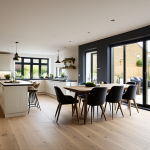Impact of Urban Development Trends on UK Real Estate
Urban development UK is reshaping the UK property market significantly. Key trends include the expansion of mixed-use projects that combine residential, retail, and office spaces, responding to changing lifestyle demands. This integration improves community connectivity and livability across cities.
Immediate effects on the residential real estate sector are visible in rising demand for well-located, modern housing near transport hubs. These developments often boost property values by offering enhanced amenities. In the commercial sector, there is a shift towards flexible office spaces and co-working environments, influenced by evolving work patterns and urban innovation.
This might interest you : How Does the UK Real Estate Market Forecast Affect Financial Investment Strategies?
Statistically, areas undergoing substantial urban development UK have witnessed price increases outperforming slower-growing regions. For example, data shows residential prices growing by up to 8% annually in high-development zones, while commercial rental markets adapt with increased turnover rates and diversified tenant profiles. These shifts underline the strong correlation between urban development and real estate trends, making them critical factors for investors and developers aiming to predict market movements efficiently.
Impact of Urban Development Trends on UK Real Estate
Urban development UK is dominated by mixed-use schemes, transport-oriented growth, and flexible commercial spaces. Each trend directly shapes real estate trends across the country and the evolving UK property market landscape.
This might interest you : What are the new trends in the UK real estate market?
Mixed-use developments combine residential, office, and retail spaces, driving up demand for properties close to amenities. This enhances community feel and livability, boosting the appeal of neighbourhoods in urban regeneration zones. Residential units in these areas are seeing significant valuation increases, as buyers prioritise convenience and lifestyle.
In the commercial sector, changing work habits fuel demand for adaptable office environments and co-working spaces. Developers respond by introducing designs that support diverse business needs. This shift reflects a broader trend of urban innovation and flexibility, contributing to rising rental turnover rates.
Statistically, regions embracing urban development UK show annual residential price growth rates up to 8%, outpacing less active areas. Commercial property markets in these zones benefit from diversified tenant profiles and improved infrastructure. These observable patterns confirm the integral role of urban development UK in steering real estate trends, underlining its critical impact on the UK property market’s future trajectory.
Impact of Urban Development Trends on UK Real Estate
Urban development UK continues to drive significant change across the UK property market, reshaping residential and commercial landscapes. Three major trends stand out: the rise of mixed-use projects, transport-oriented development, and the shift towards flexible workspaces. These trends not only cater to contemporary lifestyle demands but also stimulate real estate trends with measurable market impacts.
Residential sectors near transport hubs or mixed-use developments are experiencing heightened demand, spurring property value growth. In contrast, commercial real estate is pivoting toward adaptable formats such as co-working spaces, reflecting the evolving nature of work and urban living.
Statistically, urban development UK zones show robust market shifts. Residential prices in these areas grow up to 8% annually, outperforming less active regions. This surge is linked directly to improved infrastructure, proximity to amenities, and lifestyle enhancements. Meanwhile, commercial property sectors enjoy higher tenant turnover rates and diversified profiles, fostering a vibrant rental market.
Urban development UK thus not only uplifts property values but also supports dynamic market conditions. As these trends evolve, stakeholders in the UK property market must remain attentive to urban growth patterns for strategic advantage and continued investment success.
Impact of Urban Development Trends on UK Real Estate
Urban development UK is increasingly shaped by transport-oriented projects and mixed-use schemes, which are key drivers of current real estate trends. These developments prioritize proximity to public transit, reducing reliance on cars and encouraging sustainable urban growth. Immediate effects are evident as residential properties near transport hubs see consistent demand, often translating into accelerated price appreciation.
Commercial real estate sectors adapt by offering versatile workspaces, such as co-working environments, to meet evolving business needs. This flexibility supports urban innovation and aligns well with shifting work habits, contributing to higher rental turnover and diverse tenant profiles.
Statistically, areas with active urban development UK experience residential price growth averaging 6-8% annually, outperforming less connected regions. Enhanced infrastructure and amenities improve neighbourhood desirability, attracting investors and buyers alike. In commercial markets, the combination of mixed-use environments and transport accessibility fosters vibrant economic activity and tenant stability.
These integrated urban development UK strategies directly influence the UK property market by creating dynamic, connected communities that boost both residential value and commercial viability, guiding future investment and development priorities.
Impact of Urban Development Trends on UK Real Estate
Urban development UK currently revolves around several pivotal trends shaping the real estate sector. Firstly, mixed-use developments remain central, blending residential, retail, and office spaces to foster community interaction and convenience. These projects not only attract residents but also stimulate commercial demand by integrating amenities that enhance lifestyle quality.
Secondly, the focus on transport-oriented development continues to alter real estate trends. Properties near major transport hubs see immediate uplift in desirability and value due to improved accessibility and reduced commute times. This directly influences residential price growth and encourages investors to prioritise locations with strong transit links.
Thirdly, the surge in demand for flexible commercial spaces, such as co-working and adaptable offices, reflects the evolving work environment. These spaces support diverse tenant needs and contribute to a dynamic rental market, improving turnover rates and tenant variety.
Statistically, areas embracing these urban development UK patterns consistently outperform others. Residential price growth between 6-8% annually is typical in active zones, while commercial sectors benefit from enhanced infrastructure and tenant diversity. These shifts confirm that urban development UK remains a critical driver of ongoing real estate trends in the UK property market.




